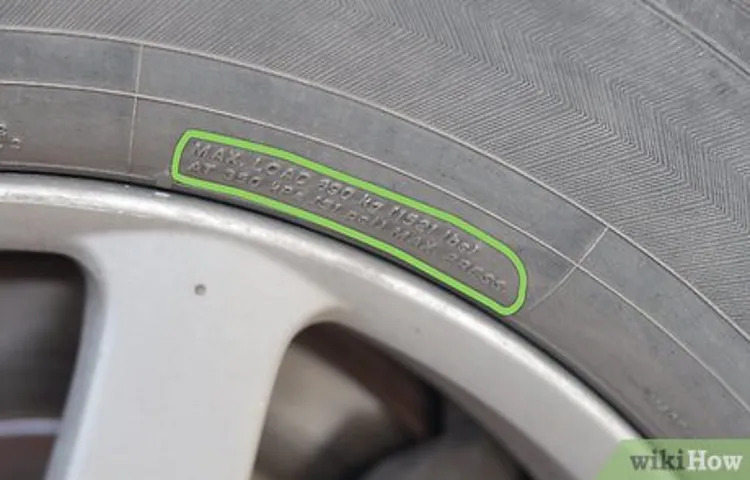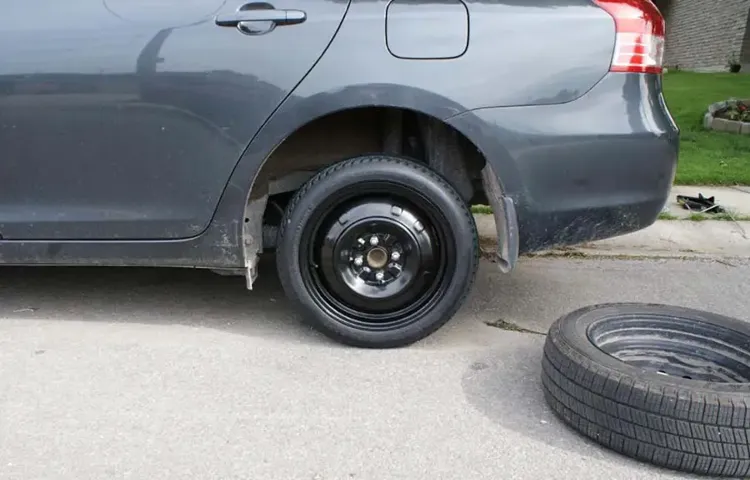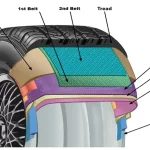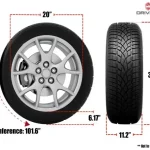Picture this: you’re running late for an important meeting and just as you’re about to hop into your car, you notice that the donut tire is flat. Panic sets in and you start wondering if you should fill it up and be on your way or take it to the nearest mechanic. But one question pops up in your mind- how much air pressure does your donut tire need? It’s a common query among drivers, especially when it comes to the temporary donut tire that comes with most cars.
After all, this tire is not like your regular tires and can accommodate only a limited amount of air pressure. And if you overinflate it, things can get pretty dangerous while driving. So, how much air pressure should a donut tire have? Is there a standard rule of thumb or does it vary from car to car? In this blog, we’ll dive into the answers to this common conundrum and help you maintain and manage your donut tire like a pro.
Table of Contents
What is a Donut Tire?
“How much air in donut tire?” A donut tire, also known as a spare tire or a compact spare, is a smaller and thinner tire that is designed to be a temporary replacement for a damaged or flat tire. When using a donut tire, it is important to make sure that it is inflated to the proper air pressure. The recommended air pressure for a donut tire can vary depending on the make and model of the vehicle, but it is typically around 60 psi (pounds per square inch).
It is important to check the owner’s manual or the label on the donut tire for the specific recommended air pressure. Over-inflating a donut tire can cause it to burst, while under-inflating it can affect the stability and handling of the vehicle. Therefore, it’s crucial to ensure the donut tire is inflated to the right pressure before driving on it.
Description of a Donut Tire
A donut tire, also known as a temporary spare tire, is a type of emergency tire that comes in handy when you experience a flat tire or a blowout. Unlike full-size spare tires, donut tires are smaller and lighter, allowing you to save trunk space and reduce the weight of your vehicle. Donut tires are designed to be used for a short period, usually until you can get a new tire or a permanent fix.
The tire’s shape resembles a donut, hence the name, and it usually has a maximum speed limit of around 50 miles per hour, making it unsuitable for extended driving. Donut tires may offer less stability, handling, and traction than standard tires, so it’s essential to drive carefully and avoid sudden maneuvers until you can replace the damaged tire. If you find yourself in need of a donut tire, it’s important to check your vehicle’s manual to know the proper installation process and limitations and remember that it’s a temporary solution, not a long-term one.

Why Do Cars Have Donut Tires?
A donut tire, also known as a spare tire, is a smaller and thinner tire that is typically used in emergencies when a car gets a flat tire. These tires are called donuts because of their circular shape, which resembles a donut. They are made of lightweight materials, such as steel or aluminum, and have less tread than regular tires.
Donut tires are designed to be used temporarily and should only be driven at a limited speed and for a short distance. So, why do cars have donut tires? The answer lies in the need for a quick fix in case of an unexpected flat tire. Rather than having to call a tow truck or find a nearby repair shop, cars come equipped with a spare donut tire that can be easily swapped out in a matter of minutes.
Donut tires are also smaller and take up less space in the trunk compared to a full-sized spare tire, allowing for more room for other items in the car. However, it’s important to note that donut tires are not meant to be a permanent replacement for a regular tire. They are designed to be a temporary solution to get you to a nearby repair shop or mechanic who can fix or replace your regular tire.
Additionally, driving on a donut tire for an extended period or at high speeds can cause damage to the tire and put the driver at risk. Therefore, it’s crucial to follow the recommended guidelines for using a donut tire and getting your regular tire fixed as soon as possible.
How Much Air Should Be in a Donut Tire?
If you’ve ever had to use a donut tire, you may have wondered how much air should be in it. Donut tires, also known as spare tires, are designed to be a temporary solution in case of a flat tire. The recommended air pressure for a donut tire is usually printed on the tire itself or in the owner’s manual of the car.
In most cases, the proper tire pressure for a donut tire is around 60 psi, which is higher than the average tire pressure for regular tires. It’s important to note that donut tires are not meant for long-term use and should only be driven on for short distances until the flat tire can be repaired or replaced. Over-inflating or under-inflating the donut tire can cause problems such as reduced handling, decreased braking ability, and even tire failure.
So, if you find yourself using a donut tire, be sure to check the recommended tire pressure and inflate it accordingly to ensure your safety on the road.
Manufacturer’s Recommendations
When it comes to donut tires, many people are unsure how much air should be in them. The answer varies depending on the manufacturer’s recommendation, but a general guideline is to inflate the tire to the maximum psi listed on the sidewall. However, it’s important to note that donut tires are not designed for long-term use and should only be used as a temporary fix until the regular tire can be repaired or replaced.
Additionally, it’s essential to follow the manufacturer’s recommendations to ensure optimal safety and performance of the tire. Keeping the donut tire properly inflated can help prevent a blowout and reduce the risk of an accident. So, if you find yourself with a donut tire, be sure to check the sidewall for the recommended psi and inflate accordingly for safe driving.
Checking the Tire Pressure
When it comes to checking the tire pressure of a donut tire, there are a few things you need to keep in mind. First and foremost, it’s essential to understand that the air pressure requirements for a donut tire might differ from those of a regular tire. A typical donut tire usually requires a higher air pressure than a regular tire.
This is due to its smaller size and the fact that it’s designed to be used temporarily. The recommended air pressure for a donut tire can usually be found in your car’s manual or on a sticker placed on the driver’s side door or glove compartment. However, the general rule of thumb is to keep the pressure at around 60 psi.
It’s crucial to keep your donut tire adequately inflated to ensure that it can adequately support the weight of your vehicle and help you get safely to your destination. So, make sure to check your donut tire’s air pressure regularly and adjust it as needed to keep your car running smoothly.
Effects of Over-inflation and Under-inflation
When it comes to a donut spare tire, it is crucial to understand the right air pressure to maintain optimal performance and safety on the road. Over-inflating can lead to bursting, while under-inflating can cause sluggishness and poor handling. Generally, a donut spare tire should be inflated to the PSI recommended by the manufacturer, which can usually be found in the vehicle owner’s manual or on a sticker inside the driver’s side door.
However, it is important to note that different vehicles may require different air pressure levels, so double-checking is always recommended to ensure safety. In summary, the right amount of air pressure in a donut spare tire is vital for effective handling on the road and avoiding any accidents that could arise from under- or over-inflating.
How to Inflate a Donut Tire?
When it comes to inflating a donut tire, the most important thing to keep in mind is to check the owner’s manual for the recommended tire pressure. Typically, donut tires require a much higher pressure than traditional tires, usually around 60 pounds per square inch (PSI). Use a tire pressure gauge to ensure that the tire reaches the recommended PSI, but be careful not to overinflate it, as this can cause the tire to burst.
Once you have reached the appropriate pressure, replace the valve cap and double-check that the lug nuts are tight before driving on the donut tire. If you’re unsure about how to inflate the tire yourself, it’s always a good idea to consult a professional or seek assistance from your local auto shop. By taking these steps, you can ensure that your donut tire is properly inflated and ready to get you safely back on the road.
Tools Required
If you’ve ever found yourself stranded on the side of the road with a flat tire, you know how important it is to have the right tools on hand to get yourself back on the road. Inflating a donut tire, or spare tire, is no exception. To get started, you’ll need a few key items, including a tire gauge, an air compressor or portable tire inflator, and a valve stem cap remover.
Once you have these tools, it’s important to locate the valve stem on your donut tire and remove the cap with the valve stem cap remover. Then, attach the air compressor or tire inflator to the valve stem and begin inflating the tire. Use the tire gauge to check the tire pressure periodically, and be sure to stop inflating when you’ve reached the recommended pressure for your vehicle.
With a little preparation and the right tools at your disposal, inflating a donut tire can be a quick and painless process. So, if you find yourself with a flat tire in the future, don’t panic – just be sure to have the right tools on hand to get yourself back on the road in no time!
Step-by-Step Guide to Inflating a Donut Tire
Inflating a donut tire can seem like a daunting task if you’ve never done it before. However, with these easy steps, you’ll be able to get your tire fully inflated in no time. First, locate your vehicle’s spare tire and remove it from its compartment.
Find the valve stem on the donut tire and remove the cap. Next, attach the tire inflator or air compressor to the valve stem and turn it on. Watch the tire pressure gauge to ensure that you don’t overinflate the tire.
Once you’ve reached the recommended pressure level, turn off the inflator and remove it from the valve stem. Finally, replace the valve stem cap and put the donut tire back in the trunk or on your vehicle. Remember, the donut tire is only meant to be used temporarily, so make sure to get the tire repaired or replaced as soon as possible.
By following these simple steps, you’ll be back on the road in no time.
Conclusion
In conclusion, the answer to the question “how much air is in a donut tire?” is simple: enough to get you to the nearest tire shop. But don’t let the small size fool you – just like a donut packs a punch of sugar and flavor, a donut tire can save the day in a pinch. So, next time you have a flat tire and need to rely on your trusty little donut, remember that it may be small, but it’s mighty enough to get you where you need to go.
“
FAQs
What is a donut tire and how does it differ from a regular tire in terms of size and function?
A donut tire, also known as a temporary spare tire, is a smaller tire that is meant to be used as a short-term replacement for a damaged or flat tire. Unlike regular tires, donut tires are usually smaller in size and have a limited speed and mileage rating.
How much air should a donut tire have and how often should it be checked for proper inflation?
The recommended air pressure for a donut tire varies depending on the make and model, but it usually falls between 60 and 80 psi. It’s important to check the tire’s pressure regularly, ideally every month or so, and to inflate it with the recommended amount of air as needed.
Can a donut tire be driven on for an extended period of time or is it only meant to be used as a temporary fix?
A donut tire is only meant to be used as a temporary fix and should be replaced with a regular tire as soon as possible. Driving on a donut tire for an extended period of time can cause additional damage to the vehicle and put the driver and passengers at risk.
How long can a donut tire be used before it needs to be replaced?
Donut tires are designed to be used for a short period of time, usually no more than 50-70 miles and at speeds no higher than 50 mph. It’s important to replace the donut tire with a regular tire as soon as possible after use.
What should I do if my donut tire is damaged or otherwise unable to be used?
If your donut tire is damaged or unusable, you should have it replaced with a regular tire as soon as possible. It’s also important to inspect the other tires on your vehicle to ensure that they are in good condition and properly inflated.
Can a donut tire be used on any type of vehicle or is it specific to certain makes and models?
Donut tires are designed to fit a specific make and model of vehicle, so it’s important to check the owner’s manual or consult with a professional to ensure that the tire is compatible with your vehicle.
How much does it cost to replace a donut tire with a regular tire?
The cost of replacing a donut tire with a regular tire varies depending on the make and model of the vehicle, the type of tire needed, and the location of the repair shop. It’s best to get a quote from a trusted repair shop in your area.



